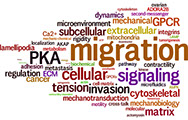Rotation Projects - Fall, 2016
-
The role of stretch-activated Ca
2+
channel, TRPM7, in regulating PKA activity during migration
- Background: Our laboratory has established that dynamic regulation of the cAMP-dependent protein kinase (PKA) within the leading edge is important for the motile behavior of many cell types (see the Publications page for references). Recent efforts to delineate the mechanism underlying this localized PKA activity have implicated a cellular mechanotransduction pathway involving actomyosin-driven contractility and TRPM7, a stretch-activated calcium channel (see the Research page for more details). These initial observations were made using expression of an inactive and dominant-negative TRPM7 mutant and need to be corroborated using more precise methods such as RNA-interference (RNAi).
- Project Goals: (1) To optimize the knockdown of TRPM7 in SKOV-3 human ovarian cancer cells; (2) to determine the effect of TRPM7 knockdown on leading edge PKA activity in live, migrating cells; and/or (3) to determine the effect of TRPM7 knockdown on stretch-mediated activation of PKA.
- Skills required (or to be acquired): Mammalian cell culture; siRNA & plasmid transfection; western blotting; immunofluorescence; live-cell microscopy & traction force microscopy
-
Localization of Kif18A in migrating ovarian cancer cells
- Background: Beautiful work from the Stumpff Lab here at UVM (check them out here) has established that Kif18A, a member of the kinesin family of microtubule-binding motor proteins, plays an important role in the mechanical control of mitotic chromosome movements and preservation of genomic integrity. Interestingly, there is evidence to suggest that this mitotic motor may also play a role during interphase, specifically within the leading edge of migrating cells. Importantly, Kif18A is over-expressed in a variety of cancers - ovarian cancer being one with particularly high expression. In an ongoing collaboration, we hypothesize that Kif18A might be playing a dual role in cancer as both a regulator of chromosome/genome stability and a facilitator of motility & invasion.
- Project Goals: To determine whether Kif18A is over-expressed in various ovarian cancer cell lines and to examine its subcellular localization in these lines during directed cell migration.
- Skills required (or to be acquired): Mammalian cell culture; western blotting; cell migration assays; immunofluorescence; microscopy
-
The role of the Kif5/Milton/Miro/APC complex in mitochondrial trafficking during migration
- Background: Cell migration is a complex behavior involving myriad biochemical events that iteratively alter cell shape and location. These events - both individually and in aggregate - require ATP to sustain their activity. Mitochondria, the principal producers of cellular ATP, are dynamic organelles that fuse, divide, and relocate to respond to cellular metabolic demands. We have recently shown that mitochondria actively infiltrate the leading edge of migrating cells as well as the distal tips of cancer cells invading a 3D extracellular matrix in a manner regulated by the AMP-activated protein kinase AMPK (check the paper out here). However, the precise mechanism through which AMPK controls this movement is not known. One intriguing hypothesis involves AMPK-mediated phosphorylation of the adenomatous polyposis coli (APC) protein and regulation of its interaction with the Miro/Milton/kinesin adaptor & motor complex that has been implicated in mitochondrial transport.
- Project Goals: (1) To knockdown APC and determine the consequences for recruitment of mitochondria to the leading edge and/or (2) to determine if (& where) APC is directly phosphorylated by AMPK.
- Skills required (or to be acquired): Mammalian cell culture; siRNA & plasmid transfection; western blotting; in vitro kinase assays; cell migration assays; immunofluorescence; live-cell microscopy
-
Mitochondrial dynamics & trafficking in glioma cells
- Background: As mentioned above, we have recently shown that mitochondria actively infiltrate the leading edge of migrating cells as well as the distal tips of cancer cells invading a 3D extracellular matrix (check the paper out here). Unlike normal cells, many tumor cells exhibit a phenomenon known as the Warburg Effect, in which they greatly increase the production ATP production through aerobic glycolysis; such cells are thought to rely less on mitochondrial oxidative phosphorylation, which begs the question of if & why this type of mitochondrial targeting might be required in such cells. Gliomas, a family of highly malignant brain tumors, are known to exhibit metabolism that is either mitochondrially-driven or shifted towards a Warburg-like aerobic glycolytic state.
- Project Goals: To examine the subcellular dynamics of mitochondria in oxidative versus glycolytic glioma stem cell lines during cell migration & matrix invasion.
- Skills required (or to be acquired): Mammalian cell culture; transfection; cell migration assays; immunofluorescence; live-cell microscopy



